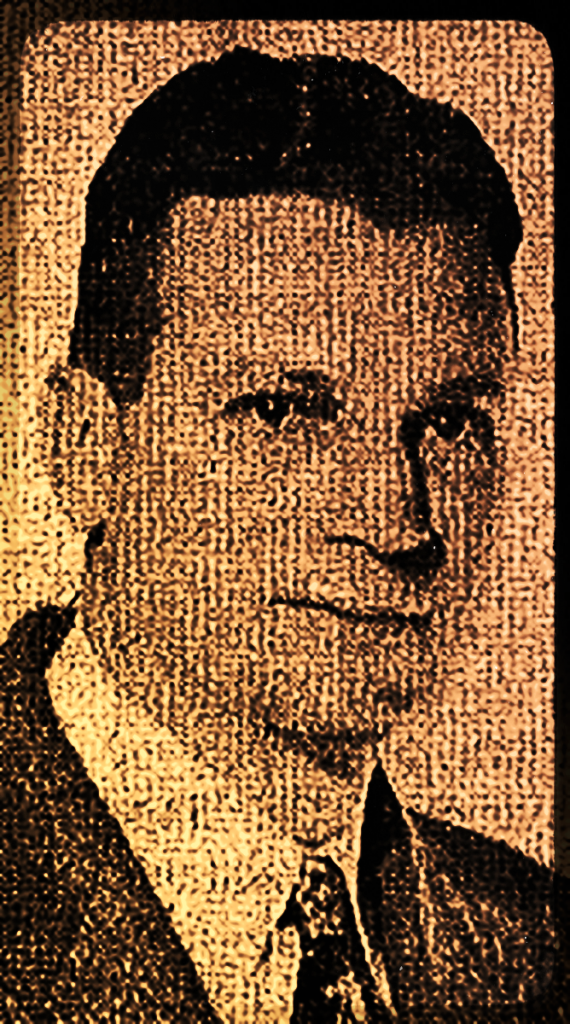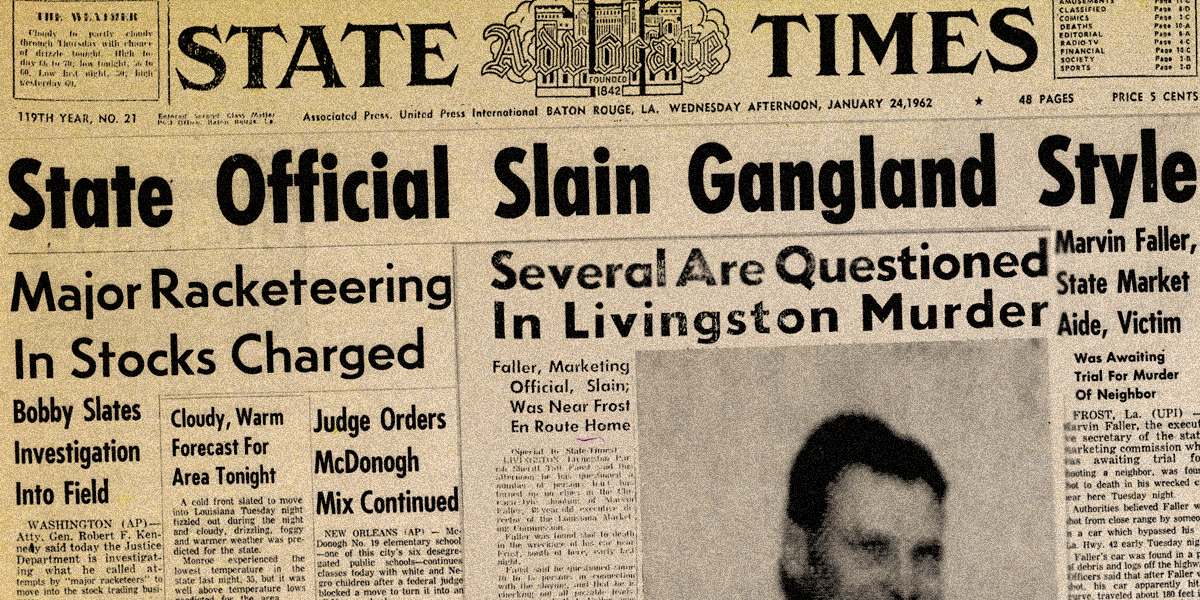Livingston bushwhack slaying remains unsolved
In 1961, Governor Jimmy Davis’ number two man in the Louisiana Department of Agriculture killed another man for trespassing on his property east of Tickfaw. However, before the state official stood trial for manslaughter, a gunman killed him on a highway south of Livingston.
Today, Marvin Faller’s murder remains a mystery.
On the evening of January 23, 1962, 48-year-old Louisiana Marketing Commission Executive Secretary Marvin Faller started his usual drive from the state capitol to his home in Ponchatoula. That morning, a relative by marriage phoned Faller, erroneously saying a truck accident caused police to close Highway 190 between Livingston and Holden. Driving home, Faller detoured down Frost Road to Highway 42 and turned west toward Springfield.
Four miles from the Frost intersection, near the Lizard Creek bridge in Springville, a second automobile began to pass Faller inside a curve. As the vehicle approached, someone inside fired a shot at Faller’s car. The slug lodged in the frame above the driver’s door. As the passing vehicle reached a parallel position, a second shot shattered the driver’s side window, entering Marvin Faller’s left temple and killing him instantly.
The victim’s car jumped the curve and glided 180 feet before crashing into a pile of logging debris, where state police officials found it before sunrise Wednesday morning. Responding to a call from a motorist, the troopers worked the scene as a traffic accident before finding the slug in the doorframe and contacting the Livingston Parish Sheriff’s Office.
A short time later, deputies assisting Livingston Parish Coroner Edwin Walker in removing the body, discovered the entrance wound, but no exit wound, in Faller’s skull.

Two months later, Livingston Parish Sheriff Taft Faust told reporters his team interviewed 15 potential witnesses, primarily area residents driving home from work between 5:30 and six the night of the murder. However, they learned nothing new.
In this interview, the sheriff corrected earlier reports that the shooter used a rifle or revolver, saying state police confirmed the slugs found came from a shotgun. The sheriff added that the closeness of the shots suggested the killer fired double-barrels consecutively rather than simultaneously. He said investigators had no suspects in the case and asked the public to help by providing new information.
One year earlier, dissatisfied with returns from a dredging operation, Marvin Faller refused to renew a tenant’s lease on property he owned three miles east of Tickfaw. An eviction notice gave the tenant, 37-year-old Ben Kinchen of Hammond, thirty days to remove all equipment from the property. Kinchen removed everything within the thirty days except a prefabricated iron gate across the gravel road into the property.
Marvin Faller’s cousin contacted me about the shooting, but she asked that I not reveal her name. “It wasn’t just that Marvin was unhappy with returns from the gravel work. Marvin found out Ben Kinchen was stealing from him, robbing him blind.”
Two months later, on a Tuesday afternoon, March 21, 1961, Kinchen telephoned Faller at the state capitol, saying he and one of his employees would remove the gate Wednesday morning. Faller forbid Kinchen from returning to the property, saying he changed the lock. The gate now belonged to him.
At 7:30 the next morning, Guy DiMattia was standing four feet above the ground on the back of a winch truck, helping his employer fasten a cable to the gate when Marvin Faller arrived with a 12-gauge shotgun.
When Faller fired a shot into the air, DiMattia ran across the flatbed, climbed the cab, and fell onto the hood of the truck. He rolled to the ground in front of the truck, just as the second blast rang out.
One hundred feet away, chicken farm worker Louis LaRocca heard the first shot. He saw Faller and Kinchen shouting but could not understand their words. The confrontation ended with Faller leveling his shotgun at Kinchen’s chest and firing from four feet away.
Tangipahoa Parish Coroner L. L. Ricks said Kinchen died instantly.

On May 4, a grand jury indicted Marvin Faller for manslaughter. Judge Horace Reid set his bond at $10,000. Raymond Shaffer and Russell Faller posted the bond that day, and Marvin Faller returned to work the following morning, prompting Ben Kinchen’s family to file a lawsuit against the State of Louisiana.
Marvin Faller’s cousin told me, “I wish Marvin had just wounded him, but Kinchen had a reputation for packing a gun everywhere he went. Marvin fired warning shots in the air beforehand, but wounding the man would have gotten Marvin shot.”
On June 23, Plaintiffs Hollis Kinchen, Bruce Kinchen, Albert Kinchen, Ivy Kinchen, Monelle Kinchen Bankston, Fannie Kinchen Jordan, Margie Kinchen Averette, and Ben Kinchen’s wife, Hilda Bankston Kinchen, sued the state and Louisiana Agriculture Commissioner Dave L. Pearce, insisting that he suspend Faller until after the manslaughter trial.
Judge Reid tossed the lawsuit three months later, and three months after that, someone bushwhacked Marvin Faller.
Sheriff Taft Faust’s plea for information went unheard until October 23, 1965, when an Albany resident told sheriff’s deputies his brother-in-law knew something about Faller’s murder. After meeting with Chief Deputy Odom Graves, the relative filed charges against his brother-in-law for disturbing the peace, allowing deputies to pick up and question Gayle White, 39, of Albany.
On November 9, Sheriff Faust invited the press to attend a news conference.
“Chief Deputy Odom Graves and Deputy Dillard Stewart have questioned White about the murder,” the sheriff said, “Under interrogation, he stated someone hired him to kill Marvin Faller, and he named two accomplices. There are some discrepancies in his statement which do not coincide with the facts surrounding the murder, so we asked White to submit to a lie detector test, and he agreed.”
The sheriff said Major Ray Herd, head of the Louisiana State Police Crime Laboratory, arranged the test, but when the time came, Gayle White told District Attorney Duncan Kemp that no one hired him. He knew no accomplices, and he did not kill Marvin Faller.
Sheriff Faust said that Gayle White worked for the Louisiana Department of Agriculture and got his job through Marvin Faller. However, the sheriff said, White became an alcoholic in the year following Faller’s death and lived for a time in state mental hospitals.
On a Monday afternoon, June 27, 1966, Hammond police arrested Gayle White after his wife charged him with Aggravated Assault. However, following the wife’s testimony, the judge reduced the charge to Disturbing the Peace and fined the husband $25 plus court costs. Gayle White told the judge he had no money, and the judge changed the fine to 30 days in the Hammond City Jail.
Thursday, July 14, 1966, at 5:05 in the evening, an officer serving food found Gayle White hanging by his neck on a belt given to him by his mother. Dr. Charles Genovese, Tangipahoa Parish Coroner, listed strangulation as the man’s cause of death.
Investigators found no suicide note, and officers described White’s demeanor three hours earlier as “jovial.”

